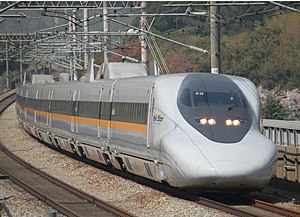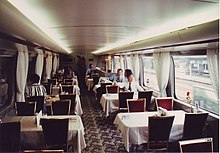 700 series Hikari Rail Star, April 2009 700 series Hikari Rail Star, April 2009 | |
| Overview | |
|---|---|
| Service type | Shinkansen (Semi-express) |
| Status | Operational |
| First service | 25 April 1958 (Express) 1 October 1964 (Shinkansen) |
| Current operator(s) | JR Central, JR West |
| Former operator(s) | JNR |
| Route | |
| Termini | Hakata (San'yō Shinkansen) Shin-Ōsaka (Tokaido Shinkansen and San'yō Shinkansen) Tokyo (Tokaido Shinkansen) |
| Line(s) used | |
| On-board services | |
| Class(es) | Green + Standard |
| Catering facilities | Trolley refreshment service (until October 2023) |
| Technical | |
| Rolling stock | 700/N700 series |
| Track gauge | 1,435 mm (4 ft 8+1⁄2 in) standard gauge |
| Electrification | 25 kV AC, 60 Hz |
| Operating speed |
|
Hikari (ひかり, "Light") is the name of a high-speed train service running on the Tōkaidō and San'yō Shinkansen "bullet train" lines in Japan. Slower than the premier Nozomi but faster than the all-stations Kodama, the Hikari is the fastest train service on the Tōkaidō and San'yō Shinkansen that can be used with the Japan Rail Pass, which is not valid for travel on the Nozomi or Mizuho trains except through a special supplementary ticket.
Service variations
West Hikari

These JR West services first appeared in 1988 on the San'yō Shinkansen between Shin-Ōsaka and Hakata using 6-car 0 series trains. 0 series 12-car SK units were employed on these services from 1989. From 11 March 2000, they were mostly replaced by the new 700 series Hikari Rail Star services, and were finally withdrawn on 21 April 2000. The West Hikari livery had a similar colour pattern to the newer 100 series rolling stock, most of which were allocated to JR Central when the Japanese National Railways (JNR) was privatised in 1987. The interior was refurbished, with the conventional 2+3 seat configuration changed to a 2+2 configuration, and the buffet car converted into a café car.
Grand Hikari

These were the premier services operated between Tokyo and Hakata from 11 March 1989 using JR West 16-car 100 series V sets with four double-deck centre cars including a restaurant car. JR West inherited no 100 series train sets when JNR was privatised. On the other hand, unlike the Tōkaidō Shinkansen, the San'yō Shinkansen had a severe competition with aeroplanes, and there was an imminent need to introduce a faster and more comfortable flagship train.

The 100 series V sets were designed to be operated at 275 km/h, but due to noise complaints, they had to reduce its maximum speed to 230 km/h on the San'yō Shinkansen (compared to 220 km/h for other Hikari services). From 11 March 2000, restaurant car services were discontinued on all trains, and from May 2002 onwards, the few remaining Grand Hikari services were limited to the San'yō Shinkansen only. The last Grand Hikari ran in November 2002.

Family Hikari
First appearing in the summer of 1995, these seasonal services operated between Shin-Ōsaka and Hakata during holiday periods using special 6-car 0 series sets (R2 and R24) which included a children's play area in car 3. All seats were reserved on these services.
Hikari Rail Star
JR West began operating the Hikari Rail Star service from the start of the new timetable on 11 March 2000. This service is limited to the Sanyo Shinkansen line, and uses special 8-car 700-7000 series trains with a distinctive livery and a maximum speed of 285 km/h. JR West introduced the service to provide better competition against airlines on the Osaka-Fukuoka route. These services do not have Green car accommodation, but the reserved seating cars feature 2+2 seating and also some 4-seat compartments instead of the standard 3+2 arrangement in non-reserved seating cars. The front row of seats in these cars feature power outlets for laptop users. With most Hikari Rail Star services being replaced by through Kyushu Shinkansen Sakura services from 12 March 2011, the 8-car 700 series sets used on the service have been running mostly on all-stations Kodama services on the San'yō Shinkansen line. As of 14 March 2020, the Hikari Rail Star is the only special service variation to run on the Hikari service.
Stopping patterns (as of june 2024)
Legend
| ● | All trains stop |
|---|---|
| △ | Some trains stop |
| Station | Tokyo – Hakata* |
|---|---|
| Tōkyō | ● |
| Shinagawa | ● |
| Shin-Yokohama | ● |
| Odawara | △ |
| Atami | △ |
| Mishima | △ |
| Shizuoka | △ |
| Hamamatsu | △ |
| Toyohashi | △ |
| Nagoya | ● |
| Gifu-Hashima | △ |
| Maibara | △ |
| Kyoto | ● |
| Shin-Ōsaka | ● |
| Shin-Kōbe | ● |
| Nishi-Akashi | △ |
| Himeji | ● |
| Aioi | △ |
| Okayama | ● |
| Shin-Kurashiki | △ |
| Fukuyama | ● |
| Shin-Onomichi | △ |
| Mihara | △ |
| Higashi-Hiroshima | △ |
| Hiroshima | ● |
| Shin-Iwakuni | △ |
| Tokuyama | △ |
| Shin-Yamaguchi | △ |
| Shin-Shimonoseki | △ |
| Kokura | ● |
| Hakata | ● |
Rolling stock
- 700 series 8-car E sets
- N700A series 16-car X/K sets, modified from N700 series Z/N sets
- N700 series 8-car S/R sets
Former rolling stock
- 0 series
- 100 series
- 300 series
- 500 series 8-car V sets and 16-car W sets
- 700 series 16-car B/C sets
-
 0 series, 1987
0 series, 1987
-
 100 Series, 1987
100 Series, 1987
-
 JR West 300 series, 8 October 2008
JR West 300 series, 8 October 2008
-
 JR West 500 series, May 2012
JR West 500 series, May 2012
-
 JR Central 700 series, April 2009
JR Central 700 series, April 2009
Train formations
N700 series (16 cars)
16-car N700 series services are formed as follows with car 1 at the Hakata end and car 16 at the Tokyo end. All cars are non-smoking except for smoking compartments located in Cars 3, 7, 10, and 15.
| Car No. | 1 | 2 | 3 | 4 | 5 | 6 | 7 | 8 | 9 | 10 | 11 | 12 | 13 | 14 | 15 | 16 |
|---|---|---|---|---|---|---|---|---|---|---|---|---|---|---|---|---|
| Accommodation | Non-reserved | Non-reserved | Non-reserved | Non-reserved | Non-reserved | Reserved | Reserved | Green | Green | Green | Reserved | Reserved | Reserved | Reserved | Reserved | Reserved |
N700 series (8 cars)
8-car N700 series services are formed as follows with car 1 at the Hakata end and car 8 at the Shin-Osaka end. All cars are non-smoking except for smoking compartments located in Cars 3 and 7.
| Car No. | 1 | 2 | 3 | 4 | 5 | 6 | 7 | 8 | |
|---|---|---|---|---|---|---|---|---|---|
| Accommodation | Non-reserved | Non-reserved | Non-reserved | Reserved | Reserved | Reserved | Green | Reserved | Reserved |
700 series Hikari Rail Star
8-car 700 series Hikari Rail Star services are formed as follows with car 1 at the Hakata end and car 8 at the Shin-Osaka end. All cars are non-smoking.
| Car No. | 1 | 2 | 3 | 4 | 5 | 6 | 7 | 8 |
|---|---|---|---|---|---|---|---|---|
| Accommodation | Non-reserved | Non-reserved | Non-reserved | Reserved | Reserved | Reserved | Reserved | Reserved |
History
Before and during World War II, Hikari was the name of an express train operated by Japan from Busan in Korea to Changchun in Manchuria.
The name Hikari was first introduced in Japan on 25 April 1958 for express services operating between Hakata and Beppu in Kyushu. This service operated until 30 September 1964, the day before the Tokaido Shinkansen opened.
When the Tokaido Shinkansen opened on 1 October 1964, the Hikari was the fastest train on the line, initially travelling from Tokyo Station to Shin-Osaka Station with only two stops (Nagoya and Kyoto). Hikari service was extended to the Sanyo Shinkansen later, although the Hikari trains were only slightly faster than the Kodama trains, earning them the derisive portmanteau nickname "Hidama." The Hikari trains remained the fastest trains until the opening of Nozomi trains on 14 March 1992.
In March 2008, the new N700 Series Shinkansen was put into service on a morning Hikari service between Shin-Yokohama and Hiroshima stations, and a late night run between Tokyo and Nagoya. A third N700 Hikari run between Nagoya and Tokyo was added in October 2008, and a few other N700 Hikari runs have since been added.
From the start of the revised timetable on 17 March 2012, Hikari Rail Star services using 700 series 8-car E sets became entirely no-smoking.
As of 2012, JR Central Hikari services operating throughout the Tokaido/Sanyo corridor primarily use 16-car N700 series and 700 series sets. Most Hikari trains pull over at intermediate stations such as Shizuoka, Hamamatsu, Toyohashi, Maibara or Himeji to allow faster Nozomi services, to pass through without stopping.
In an announcement by JR Central, JR West, and JR Kyushu made on 17 October 2023, the companies stated that all onboard smoking rooms on the Tokaido, San'yo, and Kyushu Shinkansen trains would be discontinued by Q2 2024, which took effect on 16 March 2024. In addition, all smoking rooms located on station platforms on the aforementioned Shinkansen lines would also be discontinued.
See also
References
- JR-odekake.net N700-Hikari(in Japanese)
- "JR西日本 0系新幹線「ウエストひかり」 | ヌマジ交通ミュージアム". www.vehicle.city.hiroshima.jp. Retrieved 30 December 2024.
- Suda, Hiroshi (2000). 東海道新幹線 [Tōkaidō Shinkansen]. Tokyo, Japan: JTB Can Books. ISBN 4-533-03563-9.
- "君は新幹線100系「グランドひかり」を覚えているか 2階建て車両が4両に!【E1系・E4系の画像も 新幹線・東京~博多全通50周年⑦】 | TBS NEWS DIG (1ページ)". TBS NEWS DIG (in Japanese). 13 July 2024. Retrieved 30 December 2024.
- "新幹線100系 当時(1990)の国内最速「277km/h」を記録!でも営業運転は実現せず...なぜ?【新幹線・東京~博多全通50周年⑧】 | TBS NEWS DIG (1ページ)". TBS NEWS DIG (in Japanese). 20 July 2024. Retrieved 30 December 2024.
- ^ "列車名鑑1995" (Train Name Directory 1995), published August 1995 by Railway Journal
- "グランドひかり引退へ/11月23日にさよなら運転". 四国新聞社. Retrieved 30 December 2024.
- ^ JR Timetable, March 2012 issue, p. 997
- "秋の臨時列車のお知らせ" (Press release). JR Central. 22 August 2008. Archived from the original on 24 August 2008. Retrieved 25 August 2008.
- 平成24春ダイヤ改正について [March 2012 Timetable Revision Details] (PDF). News Release (in Japanese). Japan: West Japan Railway Company. 16 December 2011. Archived from the original (PDF) on 16 December 2011. Retrieved 17 December 2011.
- ^ Kinoshita, Kenji (17 October 2023). "東海道・山陽・九州新幹線の車内喫煙ルーム、2024年春にすべて廃止" [All smoking rooms on Tokaido, Sanyo, and Kyushu Shinkansen trains will be discontinued in spring 2024.]. MyNavi Corporation. Archived from the original on 18 October 2023. Retrieved 19 October 2023.
- "Smokers bitter as cigarettes banned on all Shinkansen lines | The Asahi Shimbun: Breaking News, Japan News and Analysis". The Asahi Shimbun. Retrieved 1 April 2024.
External links
| Shinkansen | ||||||||||||||||||||
|---|---|---|---|---|---|---|---|---|---|---|---|---|---|---|---|---|---|---|---|---|
| Lines |
|     | ||||||||||||||||||
| Service names |
| |||||||||||||||||||
| Train types |
| |||||||||||||||||||
| Operators |
| |||||||||||||||||||
| Builders and owners |
| |||||||||||||||||||
| People | ||||||||||||||||||||
| Named trains of Central Japan Railway Company | ||
|---|---|---|
| Shinkansen | ||
| Limited express (daytime) | ||
| Limited express (overnight) | ||
| Discontinued | ||
| Named trains of West Japan Railway Company | ||
|---|---|---|
| Shinkansen | ||
| Limited express (daytime) | ||
| Limited express (overnight) | ||
| Limited express (commuter) | ||
| Rapid | ||
| Other | ||
| Discontinued | ||
